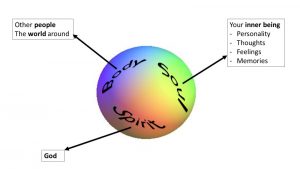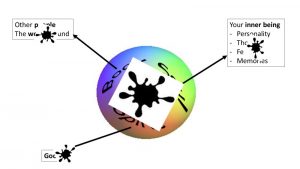In ‘Recognising Your Symptoms of Stress’ and ‘Managing Your Symptoms of Stress’ you have examined the details of your reaction to stress according to how it affects different aspects of your being – emotionally, physically, behaviourally, intellectually and spiritually. That can be very helpful – I hope it was – but it is not the full story as you are not made up of little bits cobbled together. You are a whole person. All those bits you have examined come together to make you into the unique person that you are. That explains why stress affects you differently to anyone else and why there is no simple package you can take on board to solve all your stress problems.
In this page I want you to explore the way the different aspects of your being blend together to make you the unique individual you are.
Integrative Model
You are a whole person. Ancient wisdom has for centuries described humans as being BODY, SOUL and SPIRIT. These are not separate parts but rather different aspects of the same being. The key to understanding this is by relationships. Your body is to do with your relationship to the world around including other people. Your soul is the ‘inner you’ – personality, thoughts, feelings, memories etc. Your spirit makes you unique in God’s creation because it is as a spiritual being you relate to God – you have a consciousness of God and want to relate to him at one or more levels. Every aspect of your life, however, interacts with other aspects – you are a whole person.

Of course, this imagery does not express every aspect of human nature and our interrelationships. For example: you are recognised by other people by what they see of your personality and the ways in which you express yourself (your soul, your inner being) and not just by your physical presence. This model is only a tool to help understanding of something that is beyond full understanding!
Further help may come from seeing these three images of the world:

They are different from each other but each is a true representation of the one world. It is something like that with human nature. Body, soul and spirit describe different aspects of the human person but it is one whole being that is being described.
However, you are a damaged person. Illnesses and accidents occur and they do not always resolve fully so the scars and permanent disabilities continue to affect you physically, and in your soul and spirit. You have something within you that means you sometimes make bad choices and hurt yourself and others and may carelessly damage the world in which you live. We see evidence of this in the news media day after day and you may be shocked to realise how easy it is in the passion of a moment to act out of spite or jealousy. You are also damaged by other people’s bad choices and behaviour and live in a world that is broken and suffering. That too harms you.

We are complex creatures so if anything is wrong with you it affects every aspect of your being.
For example, Graham had a heart attack so, as expected, he went into hospital for an operation and was started on a course of treatment. But there is more to Graham than a heart! To recover he needed more than treatment focussed on his heart. Graham questioned his ability to continue to cope with his work that required heavy physical effort, irregular hours and working away from home. That relates to the bodily aspects of Graham’s being. But work, to Graham, was more important than just earning a living. It was a key influence on his self-esteem and sense of significance in the world. As Graham could not work, and he feared, would never be able to again, he became depressed as his self-confidence and control over his life were affected. He grieved over the loss of the future he had expected to have. All that relates to Graham’s soul. Graham realised there was a risk that he would not survive the operation. Such a near death experience stimulated him to think about his reasons for living and the afterlife. Graham did not consider himself a spiritual person but nevertheless when the hospital chaplain visited the evening before his operation he spoke to him and welcomed his offer to pray with him. That relates to Graham’s spirit.
Similarly, you may have a stress related problem that relates to a serious difficulty at work. If only you could leave it at work! It affects you at home. It may dominate your thoughts so you do not hear when the family speak to you. You forget to ask after your partner’s day and it is ever so easy to get irritable with the children and, if you are a driver, with other road users. Your partner may not recognise that your bad mood is related to your problems at work so takes it personally. Their response will then be a reaction to their own upset, grief and hurt. You do not sleep well. You feel lethargic. You lose your sense of humour, happiness and peace of mind. You may feel guilty and ashamed. A significant stress affects every part of your being – body, soul and spirit.
Consider too what happens if your partner has an affair and your relationship fails. You will go through a period of grieving including despondency, emotional upset and anger. Your sleep pattern and appetite are likely to be disturbed. You may develop headaches or bowel problems. You may question your ability to cope with intimate relationships so may suffer from low self-esteem and may lose self-confidence. You may be angry that God has allowed this experience and suffering or may wonder if this is a punishment for a perceived previous fault. Severe stress affects every aspect of your being – body, soul and spirit.
Do you see the point of this? You are a whole person so when you are stressed every aspect of your being is affected. You may tend to focus on the aspect that gets your attention – or other people complain about! However, in order to manage your stresses adequately you must consider all these other aspects. You are a whole person and when stressed the whole of your being is involved.
And it is not just about how you cope personally. The services that you need to help you cope with stress need to be geared to help all these aspects of your being too. That happened for Graham. This model not only helped Graham understand his illness but it also was the basis for the development and organisation of the services that he needed to ensure his treatment and rehabilitation was effective. There were times when things did not work well – when he suffered adverse effects from his medication, when hospital clinics did not run to time or appointments were cancelled. He had difficulty persuading his employer to allow him to return to work with changed conditions so that his workload was less stressful. But these difficulties were only minor glitches. Graham was overwhelmingly positive about the care he had received. He praised it highly to all who enquired about his illness and reported how lucky he had been. He never thought any more of the chaplain’s visit and prayer. He had a team of medical staff who diagnosed and treated his heart attack. When he returned home his GP continued to monitor his medication, cared for other medical issues and arranged sick leave and liaised with his employer about his return to work. His rehabilitation was assisted by a team including dietitians and exercise specialists and all of them took an interest in addressing his worries and emotional stresses as well as helping with his physical recovery. Graham recognised that there was an overall plan to help him. That gave a huge boost to his confidence and expectations.
Sadly life does not always work like this.
Jigsaw and Patches Model
Bill was made redundant. It came as a shock. It was not expected. He suffered a significant grief reaction. It was an effort to get up in the morning – though he still woke up at his normal time. He was numb and could not think straight so did not fill in forms correctly. He missed Job Centre appointments so his job seekers allowance was withdrawn. He went for interviews for jobs he was qualified for but knew he made a very poor presentation. He went home ashamed and disheartened. His redundancy money did not last long. Soon he was in debt. He could not afford his mortgage. His wife was fed up with him and could not understand why he did not pull himself together. Would she leave him? Bill felt he was on a downward spiral and could not help himself. He was so used now to catastrophes he hardly cared.
Redundancy is a sort of illness, a social illness. It happens often enough. Its management too needs an integrative approach but instead Bill found help only for unrelated aspects of his care and none considered him as a whole person. He felt he was just a number. Even a nuisance. It was more as if he was a jigsaw of separate pieces and patches were applied to the bits that were not working well without any consideration for other aspects of Bill’s life.
Bill was a friend of Graham and told him about what had happened. Graham listened to his story and could see the parallels with his own experience. He had been treated so well by the NHS he suggested there would be a similar set of services to help cope with the stresses of redundancy. How had Bill missed them? He did an internet search for ‘coping with redundancy’ and then ‘coping with redundancy emotionally’ – and found very little help. Most advice was about the financial aspects such as claiming redundancy pay and then social benefits. There was some advice about looking for work. But nowhere did he find an overview describing how the statutory services processed someone who had been made redundant. Nowhere was there a full description of the emotional impact of redundancy and how it could affect so many aspects of his life.
No wonder Bill felt so lost and confused and suffered so much.

It was as if Bill was a jigsaw puzzle with each part of his life functioning as a separate entity. If one aspect was damaged or stressed, it was fixed, sort of, and that was it. There were no checks to see if it had worked – ‘like it or lump it, that is what you get.’
Bill’s emotional reaction, his grief, was not considered at all.
This model is simple and focuses on the immediate stress but it is incomplete. If problems are minor or easily fixed that is fine but it does not work well if they are at all complicated.
The idea that ‘grown men do not cry’ and the comment, ‘pull yourself together, you will be fine’ are based on this simplistic and inadequate model.
Pause for thought
 Reflect on this. Take time, dedicated time. Do it when you are not likely to be interrupted. Go for a walk or sit in your favourite spot. Turn off your phone and computer.
Reflect on this. Take time, dedicated time. Do it when you are not likely to be interrupted. Go for a walk or sit in your favourite spot. Turn off your phone and computer.
Ready?
Here are some questions that may help you in this exercise.
How do you see yourself as a whole person?
Where did you get your ideas from?
What are the strengths of your ideas about how you function and how the different aspects of your life fit together?
What are the weaknesses and drawbacks of your views?
Is there a pattern in how your stresses affect the different parts of your being?
Think about how your individual stresses have affected you.
How does seeing your stress fit into a model as described help your understanding?
Does it give you any further ideas about how you can manage your stress?
Response Button
Our ability to reflect on such questions is often helped by explaining them to others so here is an opportunity to do that. Some contributions, these are all anonymous of course, will be shared in future editions of this website.
